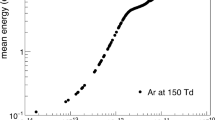Abstract
Kinetic parameters for serial pyrolysis reactions were calibrated from thermogravimetric analysis (TGA) data using Bayesian inference via Markov Chain Monte Carlo (MCMC) simulations assuming a serial reaction mechanism. Calibrations were performed for high-impact polystyrene (HIPS), bisphenol-A polycarbonate (PC), and poly(vinyl chloride) (PVC) at heating rates of 3 K/min and 10 K/min. The resulting parameter inferences are probabilistic as opposed to the point estimates calibrated in previous studies and are visualized using posterior probability density functions (PDFs) generated by kernel density estimation (KDE). Correlations between the parameters are identified and discussed. In particular, it is clear that pre-exponential constants and activation energies for a given reaction have a strong positive correlation. It is hypothesized that the degree of overlap in the posterior PDFs might be a measure of model adequacy. Point-estimates of the kinetic parameters were made by finding the mode of the posterior PDFs. For HIPS, it was determined that a one-reaction pyrolysis model is most appropriate, and that the posterior modes for \(\log \left( A_1\right) \) and \(E_1\) are \(19.5\,\log (1/s)\) and 292 kJ/mol, respectively, for the 3 K/min data. To evaluate the effect of kinetic parameter uncertainty on predictions of burning rate, samples from the posterior PDF were used to simulate gasification and cone calorimetry experiments using the fire dynamics simulator (FDS). In some cases, it was found that models with fewer parameters provided better predictions due to over-fitting associated with greater model complexity. Another important observation is that for the predictions of PVC cone calorimetry, the time to peak heat release rate can range from around 40 s to 180 s for a number of different kinetic parameter combinations that all fit the TGA data fairly well. It is argued that the proposed methodology is necessary for progress in modeling of condensed phase physics for fire problems as it supports both model validation and engineering predictions.

















Similar content being viewed by others
References
McGrattan K, Hostikka S, McDermott R, Floyd J, Weinschenk C, Overholt K (2014) Fire dynamics simulator, technical reference guide volume 3: validation. Technical report, NIST
McGrattan K, Hostikka S, McDermott R, Floyd J, Weinschenk C, Overholt K (2014) Fire dynamics simulator, technical reference guide volume 1: mathematical model. Technical report, NIST
Lautenberger C, Fernanez-Pello C (2009) Generalized pyrolysis model for combustible solids. Fire Saf J 44:819–839
Stoliarov Stanislav I, Lyon Richard E (2008) Thermo-kinetic model of burning. Technical Report DOT/FAA/AR-TN08/17, FAA
Lautenberger C, Rein G, Fernanez-Pello C (2006) The application of a genetic algorithm to estimate material properties for fire modeling from bench-scale fire test data. Fire Saf J 41:204–214
Chaos M, Khan MM, Krishnamoorthy N, de Ris JL, Dorofeev SB (2011) Evaluation of optimization schemes and determination of solid fuel properties for CFD fire models using bench-scale pyrolysis tests. Proc Combust Inst 33:2599–2606
Lautenberger C, Fernandez-Pello C (2011) Optimization algorithms for material pyrolysis property estimation. In: Fire safety ccience: 10th international symposium, College Park
Rein G, Lautenberger C, Fernandez-Pello C, Torero JL, Urban D (2006) Application of genetic algorithms and thermogravimetry to determine the kinetics of polyurethane foam in smoldering combustion. Combus Flame 146:95–108
Bruns MC, Koo JH, Ezekoye OA (2009) Population-based models of thermoplastic degradation: using optimization to determine model parameters. Polym Degrad Stab 94(6):1013–1022
Gelman A, Carlin JB, Stern HS, Rubin DB (2003) Bayesian data analysis, 2nd edn. Chapman & Hall/CRC, Boca Raton
Sivia DS (2006) Data analysis, 2nd edn. Oxford University Press, Oxford
Moser RD, Terejanu G, Oliver TA, Simmons CS (2012) Validating the prediction of unobserved quantities. Technical Report 12–32. The Institute for Computational Engineering Sciences
Overholt KJ, Ezekoye OA (2014) Quantitative testing of fire scenario hypotheses: a bayesian inference approach. Fire Technol 1–33
Overholt KJ (2013) Forward and inverse modeling of fire physics towards fire scene reconstructions. PhD thesis, The University of Texas at Austin
Stoliarov SI, Safranova N, Lyon RE (2009) The effect of variation in polymer properties on the rate of burning. Fire Mater 33:257–271
Chaos M (2013) Application of sensitivity analyses to condensed-phase pyrolysis modeling. Fire Saf J 61:254–264
Bal N, Rein G (2013) Relevant model complexity for non-charring polymer pyrolysis. Fire Saf J 61:36–44
Schwarz G (1978) Estimating the dimension of a model. Ann Stat 6:461–464
Bolstad WM (2010) Understanding computational Bayesian statistics. Wiley, Hoboken
Metropolis N, Rosenbluth AW, Rosenbluth MN, Teller AH (1953) Equation of state calculations for fast computing machines. J Chem Phys 21:1087–1092
Hastings WK (1970) Monte carlo sampling methods using markov chains and their applications. Biometrika 57:97–109
Haario H, Saksman E, Tamminen J (2001) An adaptive metropolis algorithm. Bernoulli 7:223–242
Patil A, Huard D, Fonnesbeck CJ (2010) PyMC: Bayesian stochastic modelling in python. J Stat Softw 35:1–81
Stoliarov SI, Crowley S, Lyon RE, Linteris GT (2009) Prediction of the burning rates of non-charring polymers. Combust Flame 156:1068–1083
Stoliarov SI, Crowley S, Walters RN, Lyon RE (2010) Prediction of the burning rates of charring polymers. Combust Flame 157:2024–2034
Lyon RE, Safronava N, Senese J, Stoliarov SI (2012) Thermokinetic model of sample response in nonisothermal analysis. Thermochim Acta 545:82–89
Scott DW (1992) Multivariate density estimation: theory, practice, and visualization. Wiley, New York, pp 125–190
Ceamanos J, Mastral JF, Millera A, Aldea ME (2002) Kinetics of pyrolysis of high density polyethylene. comparison of isothermal and dynamic experiments. J Anal Appl Pyrolysis 65:93–110
McGrattan K, Hostikka S, McDermott R, Floyd J, Weinschenk C, Overholt K (2014) Fire dynamics simulator, user’s guide. Technical report, NIST
Austin PJ, Buch RR, Kashiwagi T (1998) Gasification of silicone fluids under esternal thermal radiation part I. gasification rate and global heat of gasification. Fire Mater 22:221–237
American Society for Testing and Materials, West Conshohocken, Pennsylvania (2007) ASTM E 1354–04a, Standard test method for heat and visible smoke release rates for materials and products using an oxygen combustion calorimeter
Author information
Authors and Affiliations
Corresponding author
Rights and permissions
About this article
Cite this article
Bruns, M.C. Inferring and Propagating Kinetic Parameter Uncertainty for Condensed Phase Burning Models. Fire Technol 52, 93–120 (2016). https://doi.org/10.1007/s10694-015-0457-2
Received:
Accepted:
Published:
Issue Date:
DOI: https://doi.org/10.1007/s10694-015-0457-2




